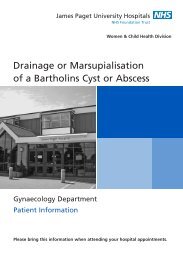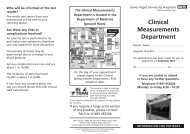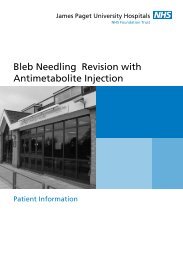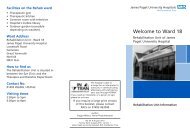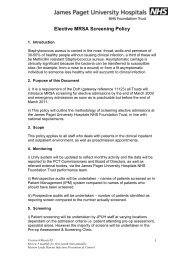Intravenous Methylprednisolone for Thyroid Eye Disease leaflet
Intravenous Methylprednisolone for Thyroid Eye Disease leaflet
Intravenous Methylprednisolone for Thyroid Eye Disease leaflet
You also want an ePaper? Increase the reach of your titles
YUMPU automatically turns print PDFs into web optimized ePapers that Google loves.
James Paget University Hospitals<br />
NHS Foundation Trust<br />
<strong>Intravenous</strong> <strong>Methylprednisolone</strong><br />
<strong>for</strong> <strong>Thyroid</strong> <strong>Eye</strong> <strong>Disease</strong><br />
Patient In<strong>for</strong>mation
What is <strong>Thyroid</strong> eye disease?<br />
<strong>Thyroid</strong> eye disease is an auto immune disease of the soft tissue<br />
such as the fat and muscles surrounding the eyes. The disease is<br />
characterised by a period of inflammation and swelling of these<br />
tissues, followed by a healing response.<br />
The body’s immune system usually fights off infection but in an<br />
auto-immune disease it attacks the body’s own tissues with antibodies.<br />
At the moment the reason <strong>for</strong> this is not entirely clear.<br />
When an auto-immune attack starts on the thyroid gland, it<br />
responds by producing more of its hormones. At the same time<br />
the auto-antibodies attacking the thyroid gland also attack the<br />
tissues around the eyes.<br />
As the soft tissue around the eye becomes inflamed, some of the<br />
following problems can occur:<br />
• The eyelids become puffy and red (lid swelling).<br />
• The muscles of the eyelids contract, producing a staring<br />
appearance (lid retraction).<br />
• The muscles and fat surrounding the eye swells, pushing the<br />
eyes <strong>for</strong>ward so that they bulge<br />
• Lid retraction and exophthalmos make the dry eye symptoms<br />
worse.<br />
• The swelling of the muscles which move the eyes produce<br />
unequal movements and double vision (diplopia)<br />
• The orbits may become painful, particularly on eye<br />
movement.<br />
In some patients who have firm tissue, the eyes may not bulge<br />
<strong>for</strong>ward. This results in the pressure inside the orbit increasing<br />
which in turn compresses on the optic nerve and causes sight<br />
problems. The optic nerve carries messages from the eye to the<br />
brain and can be damaged by this increase in pressure.
What does the treatment involve?<br />
<strong>Intravenous</strong> administration of methylprednisolone can help<br />
to reduce the pressure on the optic nerve. It may also help<br />
permanent eye damage from occurring. It works by reducing<br />
the swelling around the eyes. If the steroid treatment is not<br />
closely monitored then side effects may occur such as weight<br />
gain, thinning of the bones / skin and raised blood sugar levels.<br />
These side effects are more likely if steroid treatment is taken<br />
by mouth rather than an infusion. This is why it is only used <strong>for</strong><br />
more severe cases and is used under specialist supervision.<br />
When you attend the eye clinic <strong>for</strong> your consultation, the doctor<br />
seeing you will take a detailed clinical history from you be<strong>for</strong>e<br />
making the decision to treat your thyroid eye disease with<br />
intravenous methylprednisolone. You may also be required to<br />
have some additional diagnostic tests.<br />
<strong>Intravenous</strong> administration of methylprednisolone treatment is<br />
carried out in the eye clinic. Once you have seen the doctor and<br />
you have given consent to treatment, you will be taken to one<br />
of the examination / consultation rooms. The nurse will take<br />
your blood pressure, pulse rate, breathing rate and blood sugar<br />
levels if you suffer from diabetes.<br />
With your consent, a small plastic tube (cannula) will be<br />
inserted into the back of your hand and the intravenous<br />
methylprednisolone will be administered through a saline drip.<br />
This treatment will take approximately 1 hour. At the end of<br />
the treatment the cannula will be removed and a small adhesive<br />
dressing (plaster) will be applied. You will then be able to go<br />
home.<br />
After treatment<br />
If you have concerns following your treatment, please speak<br />
to the nurse caring <strong>for</strong> you. Alternatively you can get further<br />
advice from the eye clinic on 01493 452594
Further In<strong>for</strong>mation on thyroid eye disease can be<br />
obtained from:<br />
www.rnib.org.uk<br />
The <strong>Thyroid</strong> <strong>Eye</strong> <strong>Disease</strong> Association<br />
Solstice<br />
Sea Road<br />
Winchelsea Beach<br />
East Sussex<br />
TN 4LH<br />
The hospital is able to arrange <strong>for</strong> an<br />
interpreter to assist you in communicating<br />
effectively with staff during your stay<br />
through INTRAN.<br />
If you need an interpreter or a person to sign,<br />
please let us know.<br />
If you require a large print version of this<br />
booklet, please contact PALS on<br />
01493 453240<br />
Authors: Bridget Hemmant,<br />
Consultant Ophthalmologist and<br />
Sarah Morris, Matron.<br />
© July 2011<br />
James Paget University Hospitals NHS<br />
Foundation Trust<br />
Review Date: July 2014<br />
OP 45 version 1






